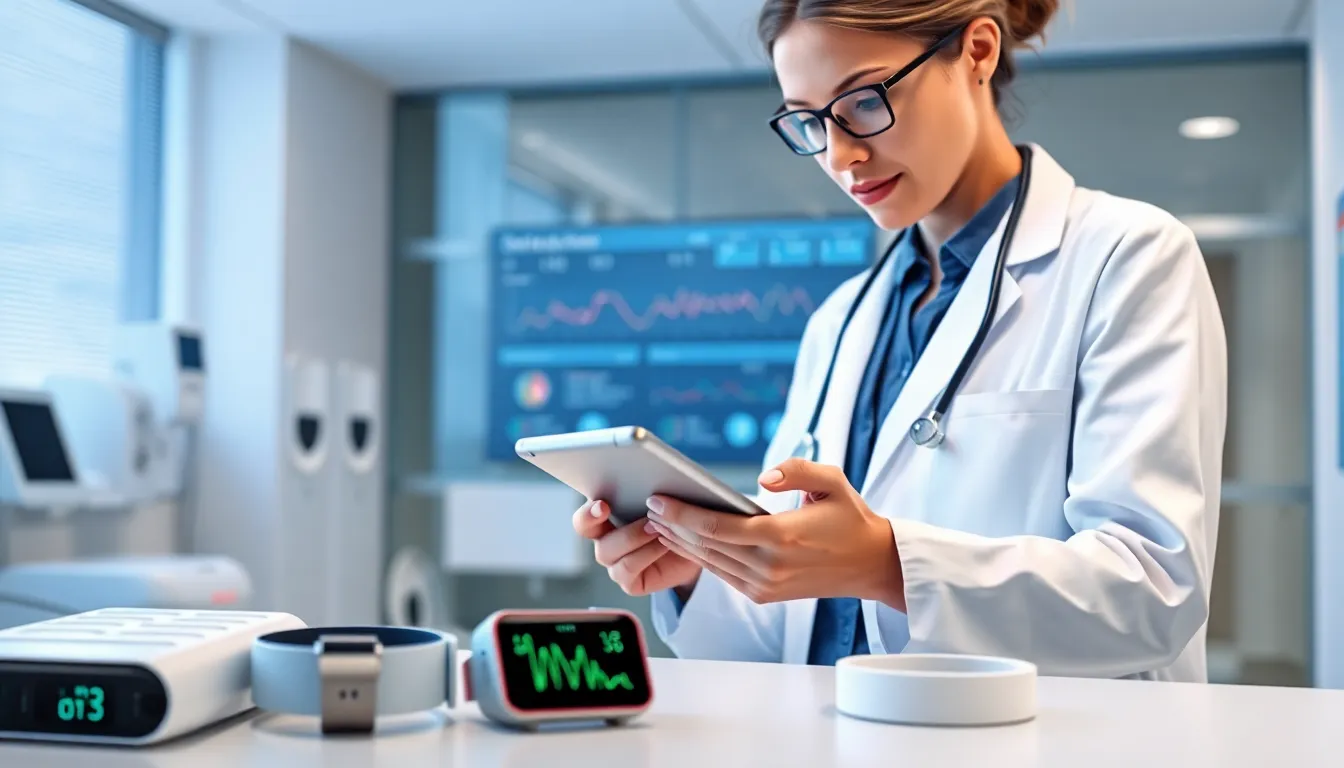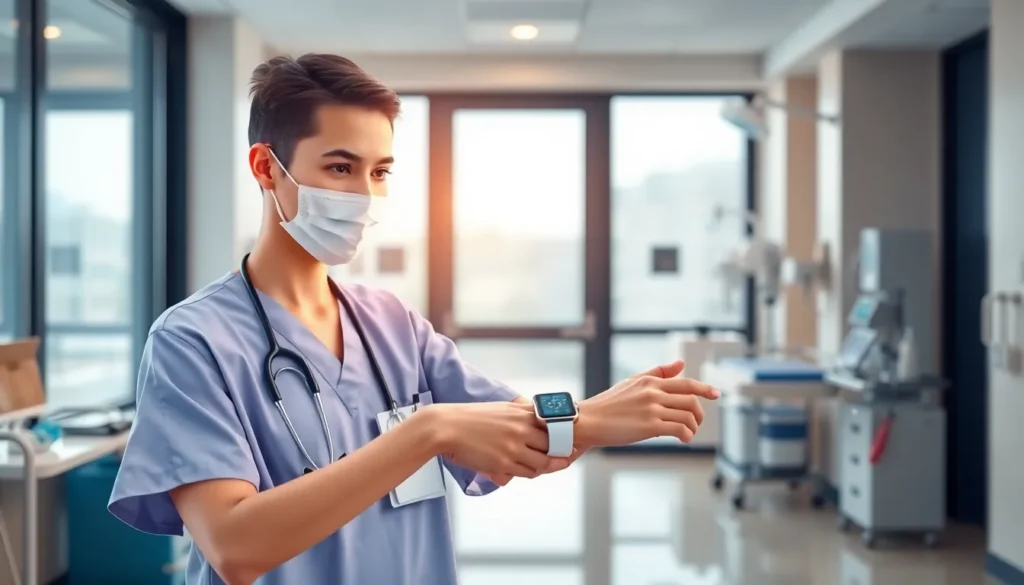In a world where your fridge can remind you to buy milk, it’s no surprise that healthcare is getting a smart upgrade too. Enter IoT healthcare, where devices don’t just sit around looking pretty—they actively work to keep people healthy. Imagine your smartwatch not only tracking your steps but also sending real-time data to your doctor faster than you can say “I need a snack.”
iot healthcare
IoT healthcare refers to the integration of Internet of Things technology in medical practices and patient care. This integration enables the seamless connection of smart devices to facilitate better monitoring and management of health conditions.
Definition of IoT Healthcare
IoT healthcare encompasses various technologies that connect medical devices and applications via the internet. These devices gather and exchange health data, allowing real-time insights into patient health. Examples include wearable fitness trackers and connected sensors in medical equipment. Collectively, these tools enhance the ability to monitor chronic diseases and support remote patient management. Telehealth solutions emerge as vital components, connecting patients with providers without the need for in-person visits.
Importance in Modern Medicine
IoT technology plays a crucial role in transforming modern medicine. It enhances patient engagement through continuous monitoring of vital signs and health metrics. Providers gain access to real-time data, enabling quicker responses to health issues. Data-driven decision-making improves treatment outcomes and reduces hospital readmission rates. Remote monitoring capabilities make healthcare more accessible, particularly for patients in rural areas. Depending on accurate data collection, healthcare professionals can tailor interventions, optimizing patient care efficiently.
Key Technologies in IoT Healthcare

IoT healthcare relies on several key technologies that enhance patient monitoring and care. Two significant contributors include wearable devices and remote patient monitoring systems.
Wearable Devices
Wearable devices play a crucial role in IoT healthcare. Smartwatches and fitness trackers gather data on heart rates, activity levels, and sleep patterns. These devices transmit real-time information to healthcare providers, facilitating timely interventions. Data collected can help identify trends and alert medical professionals to potential health issues. Patients benefit from increased engagement in their health management. Studies show that continuous monitoring through wearable technology leads to better health outcomes and lower healthcare costs.
Remote Patient Monitoring
Remote patient monitoring extends the capabilities of IoT healthcare. This technology allows healthcare professionals to track patients’ vital signs from their homes. Connected devices such as glucose monitors and blood pressure cuffs send accurate data directly to physicians. As a result, healthcare providers can analyze information promptly and adjust treatments as needed. This approach not only enhances the patient experience but also reduces hospital visits. Research indicates that remote monitoring lowers hospital readmission rates, making healthcare more efficient and accessible, particularly for patients in rural areas.
Benefits of IoT Healthcare
IoT healthcare offers significant advantages that transform patient care and operational efficiency in medical practices.
Improved Patient Outcomes
Continuous health monitoring through IoT devices significantly enhances patient outcomes. Devices track vital signs, activity levels, and other health metrics, allowing for timely interventions. Quick access to real-time data empowers healthcare providers to adjust treatment plans based on accurate information. For example, wearable insulin monitors provide critical insights for diabetes management. Studies indicate that patients engaging with these technologies show improved adherence to treatment protocols, leading to better health results. This integration also fosters proactive health management, reducing complications and hospital readmission rates.
Enhanced Efficiency and Cost Reduction
Efficiency in healthcare delivery increases with IoT technologies. By using remote patient monitoring, healthcare professionals manage many patients simultaneously, which optimizes resource allocation. Data gathered from connected devices streamlines administrative workflows, reducing paperwork and lowering operational costs. Moreover, studies demonstrate that incorporating IoT solutions can cut hospital visits by 30%. Telehealth services, powered by IoT, extend care reach significantly, especially in rural areas. As a result, patients benefit from reduced travel and waiting times, contributing to overall cost savings in healthcare systems.
Challenges in IoT Healthcare
Implementing IoT technology in healthcare presents several challenges that impact its effectiveness and widespread adoption.
Data Security and Privacy Concerns
Data security emerges as a significant challenge in IoT healthcare. Devices constantly collect sensitive health data, increasing vulnerability to breaches. Protecting patient information requires stringent security measures. Privacy regulations such as HIPAA impose strict guidelines that healthcare providers must follow. Non-compliance can lead to severe penalties. Attackers may exploit any system vulnerabilities, which compromises patient trust. Employing encryption and robust authentication measures strengthens data protection.
Integration with Existing Systems
Integration with existing healthcare systems poses another challenge. Many hospitals and clinics rely on legacy systems that lack compatibility with IoT devices. Seamlessly connecting new IoT technologies to these outdated systems can require significant resources and technical expertise. Organizations must invest in infrastructure upgrades to ensure smooth data flow. Interoperability among devices remains crucial for effective communication and data sharing. Standards for integration are still evolving, complicating the adoption process. Utilizing middleware solutions can help bridge the gap between old and new systems, enhancing functionality.
Future Trends in IoT Healthcare
Future trends in IoT healthcare indicate rapid advancements that will transform patient care and operational efficiency in medical facilities.
Advances in AI and Machine Learning
AI and machine learning technologies increasingly integrate with IoT healthcare systems. Predictive analytics utilize patient data collected from smart devices, enabling early intervention for potential health issues. Algorithms analyze trends and patterns in health metrics, offering personalized treatment recommendations. Creatively combining AI with IoT can also enhance diagnostic accuracy, as intelligent systems continuously learn from massive datasets. This leads to improved patient outcomes and optimized resource allocation, which ultimately lowers healthcare costs. Current studies suggest that AI-driven insights can reduce hospitalizations by up to 30%, highlighting its significant potential to reshape healthcare delivery.
Expanded Use of Telehealth Services
Telehealth services see expanded implementation, driven by IoT technology. Real-time monitoring via connected devices allows healthcare professionals to interact with patients regardless of location. Smart wearable devices enhance telehealth capabilities by tracking vital signs and transmitting data instantly. Patient convenience increases as virtual consultations become more accessible, effectively minimizing travel to healthcare facilities. Additionally, studies show that telehealth can facilitate up to 70% of routine check-ups, proving cost-effective for both providers and patients. Continued growth in this area reflects a shift toward patient-centered care, improving access to necessary healthcare services.
Conclusion
The integration of IoT technology in healthcare is reshaping the landscape of patient care. With smart devices enabling real-time health monitoring and data sharing, healthcare professionals can respond more effectively to patients’ needs. This transformation not only enhances patient engagement but also leads to better health outcomes and operational efficiency.
As IoT continues to evolve, the potential for predictive analytics and telehealth services will further improve accessibility and convenience for patients. However, addressing data security and interoperability challenges remains crucial for successful implementation. The future of IoT healthcare promises to deliver even more innovative solutions that prioritize patient well-being while optimizing healthcare delivery systems.

